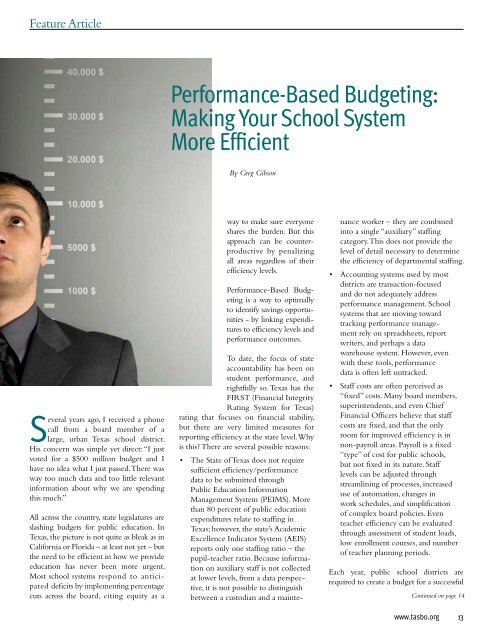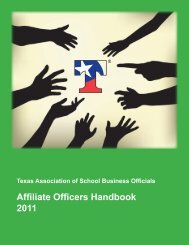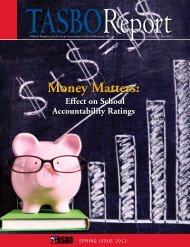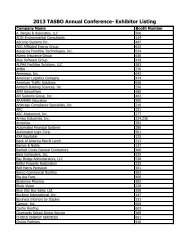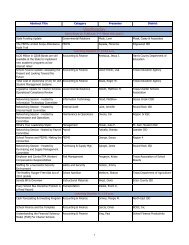June 2009 - Texas Association of School Business Officials
June 2009 - Texas Association of School Business Officials
June 2009 - Texas Association of School Business Officials
You also want an ePaper? Increase the reach of your titles
YUMPU automatically turns print PDFs into web optimized ePapers that Google loves.
Feature Article<br />
Performance-Based Budgeting:<br />
Making Your <strong>School</strong> System<br />
More Efficient<br />
By Greg Gibson<br />
Several years ago, I received a phone<br />
call from a board member <strong>of</strong> a<br />
large, urban <strong>Texas</strong> school district.<br />
His concern was simple yet direct: “I just<br />
voted for a $500 million budget and I<br />
have no idea what I just passed. There was<br />
way too much data and too little relevant<br />
information about why we are spending<br />
this much.”<br />
All across the country, state legislatures are<br />
slashing budgets for public education. In<br />
<strong>Texas</strong>, the picture is not quite as bleak as in<br />
California or Florida – at least not yet – but<br />
the need to be efficient in how we provide<br />
education has never been more urgent.<br />
Most school systems respond to anticipated<br />
deficits by implementing percentage<br />
cuts across the board, citing equity as a<br />
way to make sure everyone<br />
shares the burden. But this<br />
approach can be counterproductive<br />
by penalizing<br />
all areas regardless <strong>of</strong> their<br />
efficiency levels.<br />
Performance-Based Budgeting<br />
is a way to optimally<br />
to identify savings opportunities<br />
- by linking expenditures<br />
to efficiency levels and<br />
performance outcomes.<br />
To date, the focus <strong>of</strong> state<br />
accountability has been on<br />
student performance, and<br />
rightfully so. <strong>Texas</strong> has the<br />
FIRST (Financial Integrity<br />
Rating System for <strong>Texas</strong>)<br />
rating that focuses on financial stability,<br />
but there are very limited measures for<br />
reporting efficiency at the state level. Why<br />
is this? There are several possible reasons:<br />
• The State <strong>of</strong> <strong>Texas</strong> does not require<br />
sufficient efficiency/performance<br />
data to be submitted through<br />
Public Education Information<br />
Management System (PEIMS). More<br />
than 80 percent <strong>of</strong> public education<br />
expenditures relate to staffing in<br />
<strong>Texas</strong>; however, the state’s Academic<br />
Excellence Indicator System (AEIS)<br />
reports only one staffing ratio – the<br />
pupil-teacher ratio. Because information<br />
on auxiliary staff is not collected<br />
at lower levels, from a data perspective,<br />
it is not possible to distinguish<br />
between a custodian and a maintenance<br />
worker – they are combined<br />
into a single “auxiliary” staffing<br />
category. This does not provide the<br />
level <strong>of</strong> detail necessary to determine<br />
the efficiency <strong>of</strong> departmental staffing.<br />
• Accounting systems used by most<br />
districts are transaction-focused<br />
and do not adequately address<br />
performance management. <strong>School</strong><br />
systems that are moving toward<br />
tracking performance management<br />
rely on spreadsheets, report<br />
writers, and perhaps a data<br />
warehouse system. However, even<br />
with these tools, performance<br />
data is <strong>of</strong>ten left untracked.<br />
• Staff costs are <strong>of</strong>ten perceived as<br />
“fixed” costs. Many board members,<br />
superintendents, and even Chief<br />
Financial Officers believe that staff<br />
costs are fixed, and that the only<br />
room for improved efficiency is in<br />
non-payroll areas. Payroll is a fixed<br />
“type” <strong>of</strong> cost for public schools,<br />
but not fixed in its nature. Staff<br />
levels can be adjusted through<br />
streamlining <strong>of</strong> processes, increased<br />
use <strong>of</strong> automation, changes in<br />
work schedules, and simplification<br />
<strong>of</strong> complex board policies. Even<br />
teacher efficiency can be evaluated<br />
through assessment <strong>of</strong> student loads,<br />
low enrollment courses, and number<br />
<strong>of</strong> teacher planning periods.<br />
Each year, public school districts are<br />
required to create a budget for a successful<br />
Continued on page 14<br />
www.tasbo.org 13


